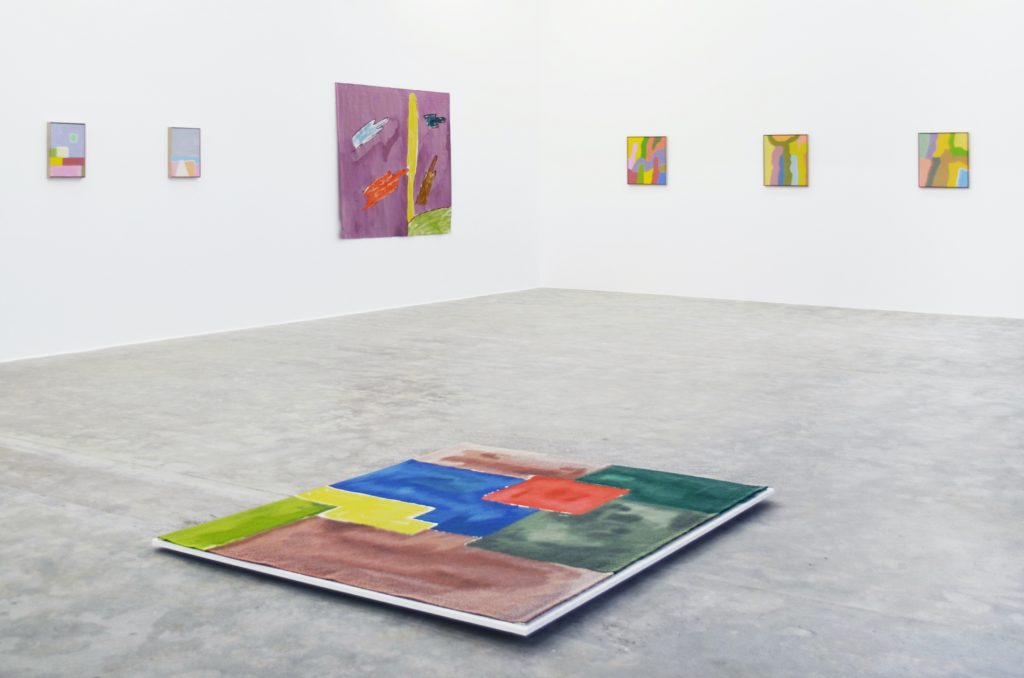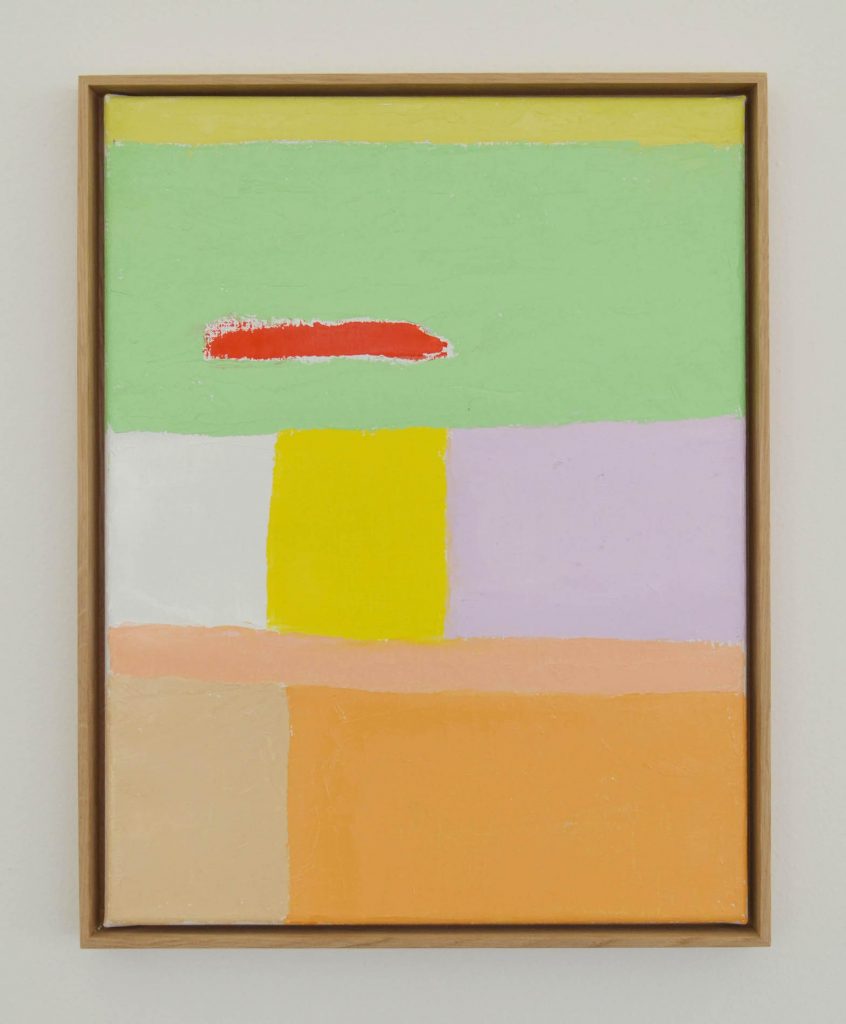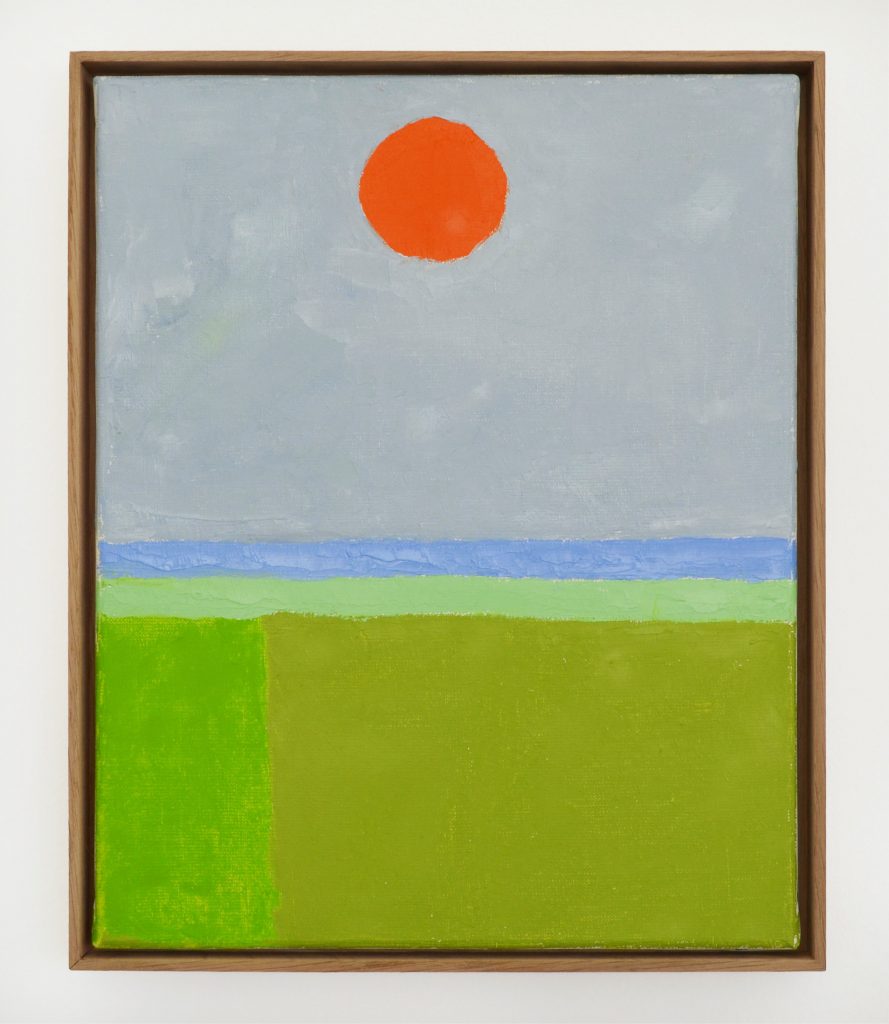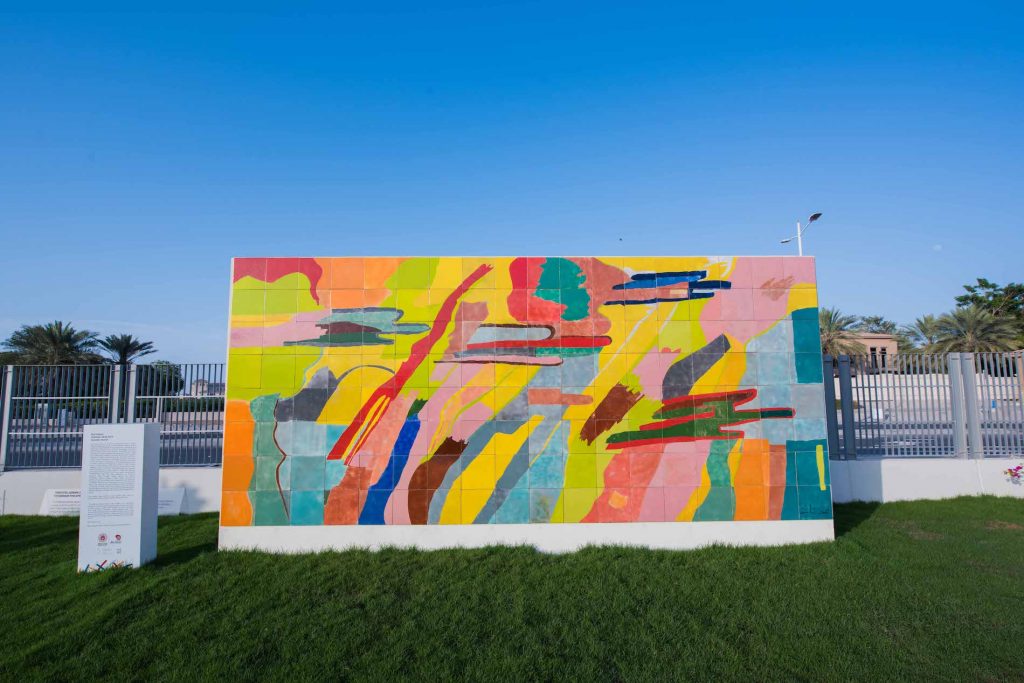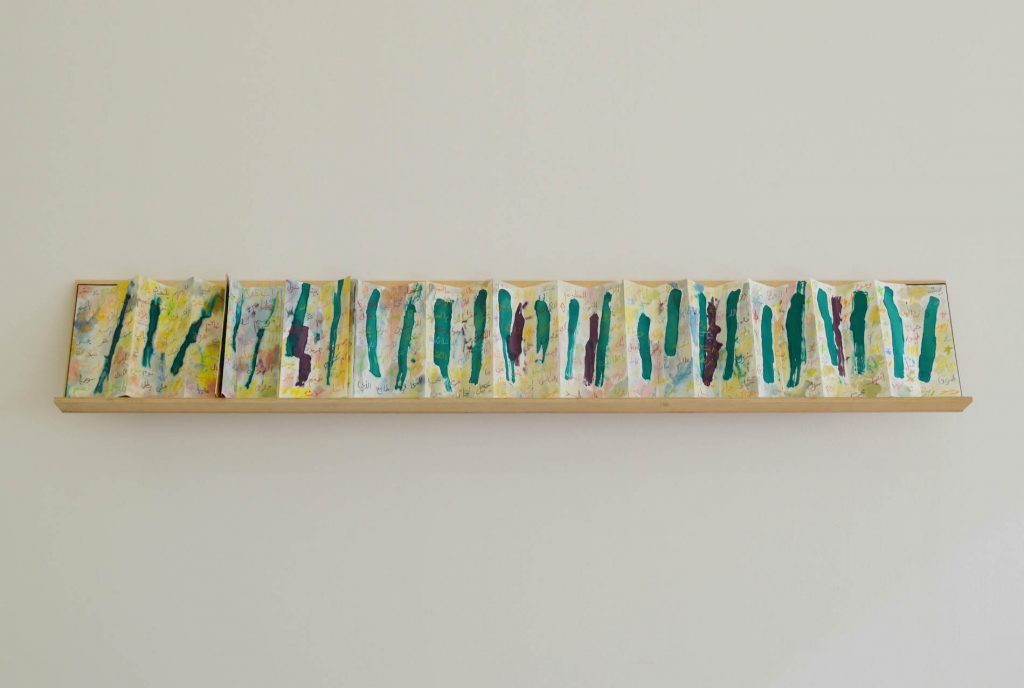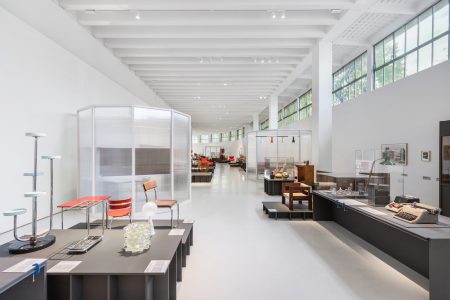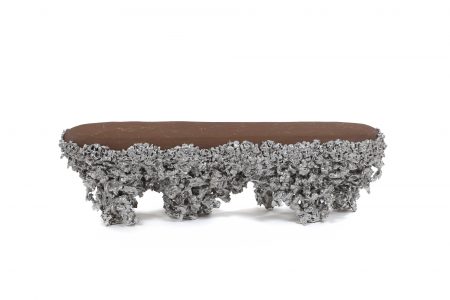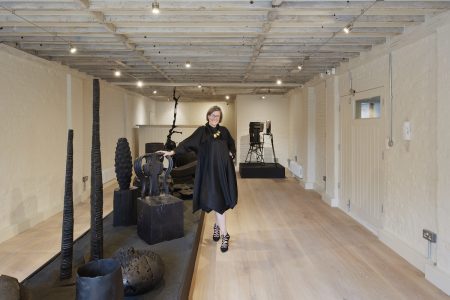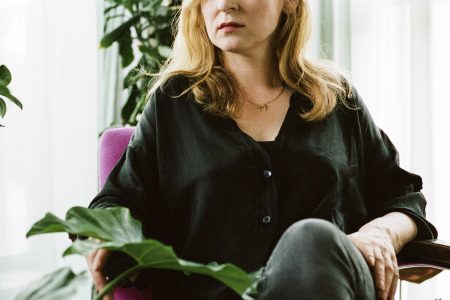Etel Adnan’s paintings ask the question: What is painting?
Speaking to Etel Adnan, vast expansions of landscapes, mountains, rivers, and plains are explored. She wants to go there, and so she does.
Etel Adnan sits at her table, puts down a small surface of the canvas, well-stretched on a wooden frame, and starts mixing colour. She does not always start, as she used to do, with a red square, a mark that helped her begin organising the space around it. She does not need this anymore. She is much freer. She sees these vast expansions of landscapes, mountains, rivers and plains. She wants to go there, and so she does.
In what way can we say that she sees these places? She does not imagine them; she is in them. She sees them. Therefore painting is a simple tool for moving around, travelling and seeing. Imagining. Painting comes first, then the imagination. Is seeing imagining? Do we want to express the world as we see it, or do we create the world we want to see?
There is a deep movement, a geyser, which pushes you towards the pencil and the colour. It is a mystery.
It is a gesture that preceded writing, as we see it in the prehistoric grottos. Men and women drew the world around them, or as they thought they needed to. What is this need? Let us examine the prehistoric paintings. A marvellous world in movement. Bison, horses running. The need to run, to move; I guess that it was very difficult to move 35,000 years ago. The world was a threat, a constant threat: animals ready to attack, the very cold climate, rare food that one had to run after. To create. Few vegetables. Man was constantly assessing what he could eat; in order to find vegetables, he had to try and experiment.
The only thing he loved was these animals, running. Companions, enemies. To be tamed, to be won over. He saw them, he lived with them. They took him places. How did he get underground? Once he was in a relatively safe place he started drawing. Drawing is recollecting, is calling. Calling to life, and rescue. He drew masterfully, reproducing his world outside, an ode to his environment.
A hand-drawn on the wall. One of a woman. I am here, this is me. This is where I lived and thought. This is what I think. What I see and love. Etel Adnan does the same. In one of her earlier leporellos she puts her hand down and draws its contours, a mark. She marks. This is me, this is where I am. I am happy to be here. She draws practically every morning when she is in a period of painting. For she is also a writer and when she writes, she puts away with extreme sadness the tubes of colour. But when she spreads them on her table, she is very happy again. She places on the table a crystal paper on which one mixes colours. This is the enjoyable part. This paper is in a form of a palette, white and translucent, helps her in its fragility not to take the action too seriously. It is indeed a playful action. She is free to proceed to wherever she wants to go. There are whole sections of paintings that are a playful action.
But it is also a very serious endeavour. How can I explain the seriousness, since we have just said that it is a playful action? Once she has decided to go ahead with a painting, then she enters the very serious world of the putting down of a universe, exactly as she should put it down. This world, which did not exist a second ago, is going to get very serious and achieve its very existence. An existence that will be even more alive and exact than what we see, and what has produced it, what has been its pretext. The mind proceeds by mixing together; exactly in the same way that Adnan mixes her colours, the mind mixes all these images that it has seen. They go ‘somewhere’ in the imagination, i.e. an imaginative world, for the imagination is not the faculty we think it is: thinking something that does not exist. No, it is creating something that has a bigger life and a truer life than the one we see in the everyday, in the apparent world, the world we take for the ultimate reality. For painting produces a world that is more real than the one we see; it gives us the essence of it, its substance and core. It gives us its significance and finality. What is beauty, why beauty, what is a colour? What is a hill or a bison? It gives us the translation of it in another dimension. The painting is a translation that the vision brings to the paper, its existence in a parallel world. This parallel world explains the first world. We call it art, for we don’t know what it means, really.
It starts with a need to do it. The need does not explain itself, it surges and takes one over. Irresistible. No explanation. I am possessed suddenly by the urge of the surge. For suddenly I have understood something and it is my duty to put it down, first for me, for I am in my urgency, then when it is over, and I have done it, I realise it is important and it should be seen by many other persons. The thread of thought takes you by the hand, the thread of Ariadne takes you into the labyrinth. It takes you from discovery to discovery.
The discovery is a recognition of what you have in mind. Suddenly you see what is there buried in your mind, for the hand has made it appear. There is mixing up, there is superposition of what is in the mind and what is made by the hand; one has imprinted on the other. It is the result of two worlds. I al- ready said it is a translation, like Charles Baudelaire translating Edgar Allan Poe. The reading of the final text makes you hear the voices of Baudelaire and of Poe together at the same time. You distinctly hear both. And not one. Do you see both? Of course.
To go back to Etel Adnan’s universe: she is in her room, she sees no mountain or hills from her window. And yet here they are on the canvas. She says proudly, ‘I want to go there.’ And actually she does go there, and the canvases tell us where she’s been, and we share the experience.
My first teacher/painter friend started by telling me: painting is about solving a problem. You put down an equation, i.e. a few lines, blue, red or yellow. Then you have to make a painting out of it. What is a painting? A surface organised into a coherent whole that tells you something about something.
I would argue that painting is not about producing a coherent whole. It is about finding something to tell the world that has not been there before. The bison on the walls of the grottos are not the bison running outside in the dark. They proceed from another reality. The reality of the mountain on the canvas, the way I put it down in my own paintings.
This moment I tried to talk about, the setting of the sun over Mount Sannine, which I have tried to render over and over again, tells me more about myself looking at this wondrous phenomenon than all my souvenirs of these hours of contemplation. It tells me how I was, how I looked, how I loved, and how I wanted the world to love this moment of adoration of the universe. It speaks about both of us. The mountain and me. And therefore it speaks about both of us at the same time. Man inside his universe.
A painting by Etel Adnan not only tells us about the universe at that particular time and day, but the way she was feeling at that particular time and day, the tenderness felt and experienced, or the anger.
This is what Etel Adnan’s painting has taught us to understand. To hear both the voice of the universe and man inside it. At the same time.
This article is republished from TLmag 33: New Age of Humanism.
Cover image: Etel Adnan, 2012©Gilles BassignacCourtesy of the artist and Sfeir-Semler Gallery Beirut/Hamburg
